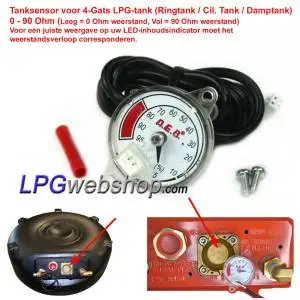 | LPG-Tank Level Sensor 0-90 Ohm for 4 Hole LPG-tanks | +€17.96 |
- -20%
Choose: With or Without Gas Tight Housing
Foreign companies with a valid VAT number shop VAT-free here! READ HOW.
 Safe & Trusted
Safe & TrustedWebshop Trustmark Certified Member & Secured by SSL.
 TÜV ISO 9001
TÜV ISO 9001Certified by TÜV Nord Netherlands
 Delivery policy
Delivery policySafe and Secure Shipping with DPD or DHL
 Refund policy
Refund policy14-Day Reflection Period & Return Policy
Before ordering first check very carefully which type of LPG tank and which dimensions you need and what fits in your application. Exchanging an LPG tank is sometimes difficult, since the transport of heavy tanks is per pallet and is expensive. (Pick up may also be possible.)
This type of LPG tank produces liquid LPG which is used as car fuel. Suitable for built-in and substructure (below vehicle) installation at the location of the spare wheel (depending on the available space).
Suitable for most LPG systems: Landi Renzo, Vogels VGI, Eurogas, Prins VSI, BRC, Romano, Tartarini, AEB, etc.
NB! This type of LPG Tank has NO LPG Pump and is NOT suitable for Vialle LPi, for example.
If the LPG tank is placed inside the vehicle, the use of the optional gas tight housing is mandatory and it must be mounted gas-tight. To be used in combination with a vent hose and a bottom vent for discharging any gases to the outside.
This LPG tank is not suitable for heating and cooking on vapor gas as used in Motorhomes and Foodtrucks.
A gas-tight housing is used to protect the tank accessories (tank valves) and, in the case of built-in installation, to collect any gases from the LPG tank and then vent them to the outside via a ventilation hose and a bottom vent (floor feed-through). A gas-tight housing is certainly required if the LPG tank is placed inside the interior of a vehicle and must be connected in a gas-tight manner using the supplied rubber seals. A gas-tight housing is not strictly necessary if the LPG tank is placed in an exterior space (for example, in an underbody/underslung installation) or in a ventilated compartment (which is sealed off from the rest of the vehicle). However, it is always necessary to protect the accessories from dirt and water.
If a gas tank is installed inside the interior of the vehicle (built-in installation), it is necessary to equip the gas tank with a gas-tight housing, a ventilation hose, and a bottom vent (floor fitting) to vent any gases to the outside.
It is not always possible to make a gas tight housing properly gas-tight when used in combination with a hand valve....
When using a Hand Valve SHELL connection Male G.5 Kombi (G.2/G.4/G.8) (W21.8x1/14 Left-Hand Thread), it is NOT possible to properly seal the housing gas-tight, meaning this combination is essentially only suitable for underslung installation or, in the case of built-in installation (interior space), only in a ventilated compartment that is sealed off from the rest of the vehicle.
When using a hand valve with an 8mm compression fitting that is directed straight outwards, the housing also CANNOT be made properly gas-tight, as there is then insufficient space to place a gas-tight plastic sealing boot.
In the case of a hand valve with an 8mm compression fitting, the housing can be made gas-tight if the hand valve is oriented with its outlet facing inwards. (The gas line can then be looped inside the housing or exit the housing on the same side as the fill hose).
Tank sensor: A tank sensor fits on the outside of the tank meter and rotates with the magnetic field of the tank meter and thus varies an elec. resistance value. The correct resistance curve for your car depends on the type of LED indicator and the gas system. Your application is unknown to us, therefore NO tank sensor is supplied as standard. When replacing, you can in principle simply transfer your current tank sensor from your old tank to the new tank. You can order a 0-90 Ohm sensor (most common type) separately. The tank does not need to be opened to insert or transfer the tank sensor. This is on the outside and is secured by means of two small screws.
Have a gas tank installed by an authorized specialist! And have the entire installation inspected by a competent authority.
For a solid and safe installation, apply the guidelines of your national authority.
Apply a minimum distance of 20cm to the road and 10cm to heat sources like the exhaust.
This type of LPG toroidal tank can be placed on the location of the spare wheel. This can be at the spare wheel well inside the vehicle or as LPG substructure in case the spare wheel is placed under the car. Read the related tutorials and instructions under attachments.
Use a FIXATION REAR KIT FOR TOROIDAL TANKS or have a look at all our tank FIXATION MATERIAL.
Find more information about the correct installation and mounting of an LPG tank in our manual: LPG-TANK INSTALLATIE INSTRUCTIES
In case of LPG substructure: Gas tank and valves provided with a protective coating (undercoating) for longer life. Repeat this annually.
Data sheet